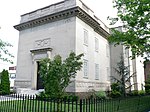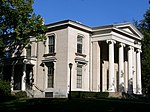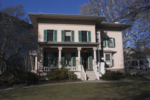Russell Henry Chittenden House
Historic district contributing properties in ConnecticutHouses completed in 1887Houses in New Haven, ConnecticutHouses on the National Register of Historic Places in ConnecticutNRHP infobox with nocat ... and 2 more
National Historic Landmarks in ConnecticutNational Register of Historic Places in New Haven, Connecticut

The Russell Henry Chittenden House is a historic house at 83 Trumbull Street in New Haven, Connecticut. Built in the 1880s, it was the longtime home of Russell Henry Chittenden, who lived there from 1887 to his death in 1943. Chittenden, known as the "father of American biochemistry", was a professor at Yale University, and the house was declared a National Historic Landmark in 1975 in recognition of his importance.
Excerpt from the Wikipedia article Russell Henry Chittenden House (License: CC BY-SA 3.0, Authors, Images).Russell Henry Chittenden House
Trumbull Street, New Haven
Geographical coordinates (GPS) Address Nearby Places Show on map
Geographical coordinates (GPS)
| Latitude | Longitude |
|---|---|
| N 41.313416666667 ° | E -72.922972222222 ° |
Address
Trumbull Street 85
06511 New Haven
Connecticut, United States
Open on Google Maps








